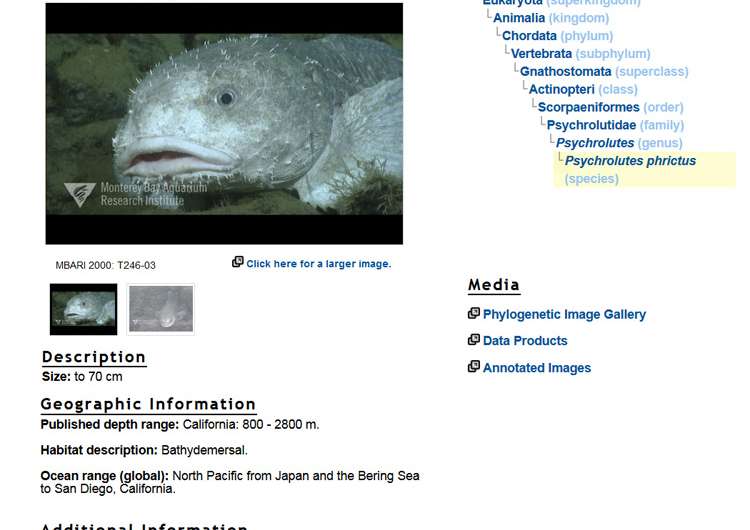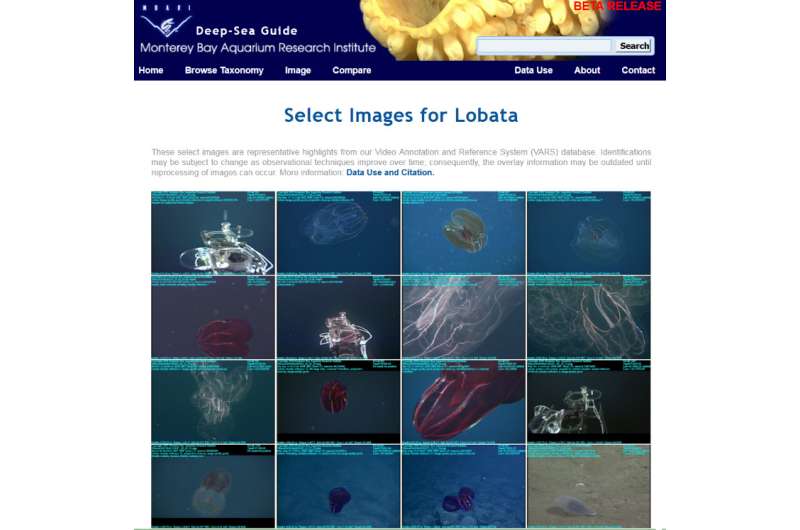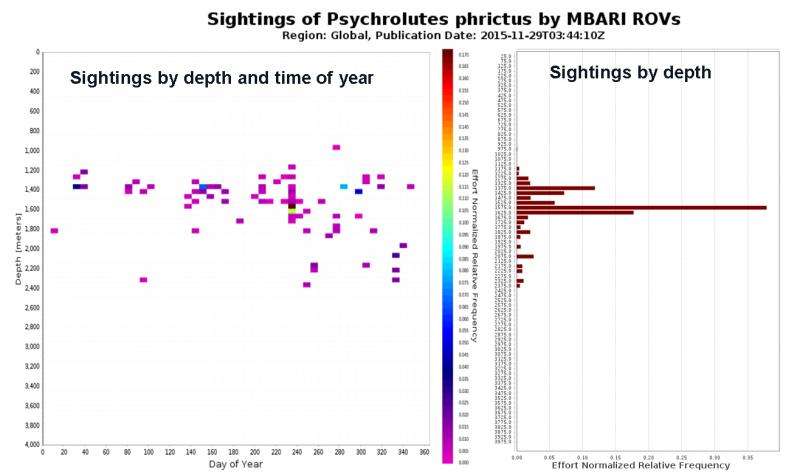New website catalogs thousands of deep-sea animals and seafloor features

A new online tool makes it easy for anyone to search a treasure trove of information about deep-sea animals and scientific observations. The Deep-Sea Guide, created by the Monterey Bay Aquarium Research Institute (MBARI), provides easy access to the institute's database of millions of records of deep-sea animals, seafloor habitats, geological features, and research tools. Previously only available for internal use, the Deep-Sea Guide is now available for scientists and the general public.
MBARI sent its first remotely operated vehicle (ROV) equipped with a video camera into Monterey Bay in 1988. Since then MBARI has recorded over 24,000 hours of underwater video, along with related information such as water depth, temperature, and oxygen concentrations. With all this data and video flowing in, researchers needed a way keep track of everything that was recorded and to make the information accessible and useful for continuing scientific study.
MBARI video analysts and software engineers responded to this challenge by developing the Video Annotation and Reference System (VARS)—a software package that technicians use to annotate video, describing animals and other objects recorded during ROV dives. What began as a box of notes and Polaroid prints of common deep-sea animals eventually developed into a rich electronic reference guide. As of November 2015, the VARS database held nearly five million annotations.
At the heart of the Video Annotation and Reference System is the knowledge base—a catalog of biological, geological, and technical terms that allows researchers to describe the underwater scenes quickly and consistently.

The Deep-Sea Guide allows anyone to search for concepts from the VARS knowledge base. For example, a user can search for a particular deep-sea animal by its common name (blob sculpin) or by its Latin name (Psychrolutes phrictus) or even for groups of animals (sculpin), geologic features (hydrothermal vent), or research tools (suction sampler).
The results of a search using the Deep-Sea Guide can include images, physical descriptions, and range information, as well as graphs of the depths and times of year the animal or object was observed.
After several years of using the Deep-Sea Guide internally, MBARI researchers are now ready to release a beta version for external researchers and the general public.

Video Laboratory Supervisor Nancy Jacobsen Stout, who managed the project to develop the Deep-Sea Guide, explained, "This latest installment in our suite of tools was built by our video annotation team over the course of about 20 years with tremendous amounts of labor and love! It represents the collective efforts and evolving knowledge of a diverse group of MBARI scientists, research technicians, and engineers. Our hope is that the guide will serve as a tool to foster more in-depth engagement with our colleagues in science and education, and will help us share the wonders of the deep sea with general audiences."
MBARI researchers continually enrich the content of the guide by updating names, descriptions, and visual information as their knowledge grows.
They hope that the Deep-Sea Guide will improve the exchange of information within the oceanographic research community.
To this end, they encourage other scientists to suggest improvements and explore potential collaborations.
"The Deep-Sea Guide is an excellent way for MBARI researchers to connect with expertise from around the world, as it allows deep-sea experts to quickly browse our data and provide feedback, improvements, and corrections," said Software Engineer Brian Schlining. "The curated images in the guide also provide an excellent identification tool for researchers and students all over the world." The Deep-Sea Guide and VARS team includes Nancy Jacobsen Stout, Linda Kuhnz, Lonny Lundsten, Brian Schlining, Kyra Schlining, and Susan von Thun. Please feel free to contact team members for additional information about the website and its content.
The Deep-Sea Guide allows users everywhere to dip their toes into MBARI's research data and see for themselves the astonishing diversity of animals and geologic features in the deep sea.
Provided by MBARI




















